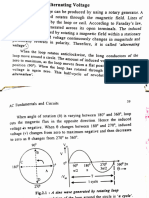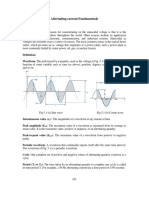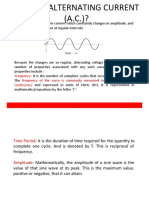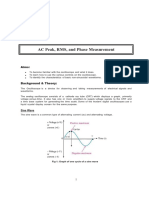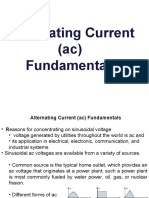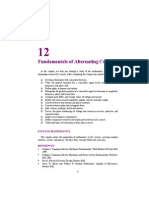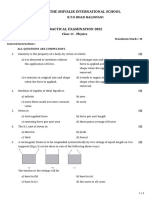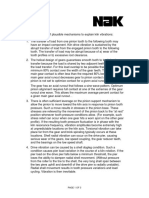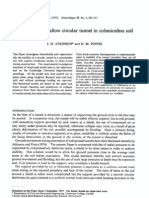ALTERNATING QUANTITIES
A quantity (Current or voltage)which is continually changing its sign from positive to negative and
back again is called an alternating quantity, usually referred to simply as an a.c. quantity. Examples
of alternating quantities are shown in Fig. 1(a) and (b). The quantities shown in Fig. 1(c) and (d) are
not alternating but are varying direct quantities.
FIG 1
A graph of the quantity to a base of time is called the waveform of the quantity and when the
waveform has completed one complete series of changes and is about to begin to repeat itself it is
said to have completed one cycle. The time for one complete cycle is termed the periodic time (T) or
simply the period. The number of complete cycles completed in one second is called the frequency
(f) and is measured in cycles per second which is called the hertz (Hz) in honour of Heinrich Hertz
(1857-94), a German Scientist. It follows that f = 1/T.
SOLVED EXAMPLE 1
Determine (a) the periodic time of an a.c. quantity of frequency 50 Hz, (b) the frequency of an a.c.
waveform for which the period is 2.5 ms.
Instantaneous values
An alternating quantity changes its magnitude from instant to instant over the cycle time. These
values are called the instantaneous values of the quantity. They are the values at a particular instant
or time.
Peak values
The highest value reached by a quantity in the cycle is called the maximum (or peak or crest) value.
1
�Cycle – one complete set of positive and negative values of an alternating quantity. It can be
specified in degrees or in radians.
Period
This is the time taken for the alternating quantity to complete one cycle.
Frequency
This is the number of complete cycles made by an alternating quantity in one second.
Amplitude
This is the maximum value-positive or negative, of an alternating quantity.
Sinusoidal a.c. quantities
This is one that has a sine waveform . it may be symmetrical or asymmetrical. A sine waveform is
obtained by plotting a sine function.
The only a.c. waveform which when differentiated (or integrated) gives the same waveshape is the
sine wave. For this reason the sinusoidal waveform in the most commonly encountered waveform in
electrical engineering. The instantaneous value for sinusoidal voltage and current may be
represented mathematically by
v = Vm sin wt or
v = Vm sin θ
i = Im sin wt or
i = Im sin θ
the Root mean square value(rms) of an ac quantity is the effective value of quantity (current or
voltage). It is the value at θ = 450. It is given as
Im
I rms =
√2
Vm
V rms =
√2
characteristics of a sinewave
a sinusoidal ac waveform has the following characteristics:
1) It’s one cycle spreads over 3600 or 2 π radians
2) Its polarity reverses every half cycle.
3) It has maximum positive value at 900 and maximum negative value at 2700.
4) It has zero value at 00 and 1800.
5) It changes its values fastest when it crosses the zero axis
6) It changes its value the slowest when near its maximum value-whether positive or negative
Phase of an AC
The phase of an ac current (or voltage) can be defined as the fraction of a cycle or time period that
has elapsed since the ac quantity (current or voltage) last passed a given reference point(usually the
starting point). It can be expressed in:
1) Time (measured in seconds), or
2
� 2) Fraction of a time period, or
3) Angle expressed either in radians or degrees
In fig 2, the phase of point A is :
π
radians or 300
6
1 T
th (one-twelfth) of a cycle or second or
12 12
1 1 1
× = second
12 50 600
π T 1
Similarly, the phase of point B is radian or 900 or or or second.
2 4 600
Phase Difference
Not all sinusoidal waveforms will pass the zero axis point at the same time, there may be a shift to
the right or the left when compared to another sine wave. This phase shift or phase difference is the
angle in degrees or radians a waveform has shifted from a certain reference point along the
horizontal zero axis. In fact, the phase difference between two alternating quantities is more
important that their absolute phases. The terms “lead” or “lag” can be used to indicate which of the
comparing sinusoidal quantities reach peak first. A leading quantity is one which reaches its peak
/maximum (or zero value) earlier as compared to the other quantity. Similarly, a lagging quantity is
one which reaches its peak /maximum (or zero value) later than the other compared quantity.
a) b)
3
� c) d)
In a) A leads B by 600 (or B lags behind A by 600)
In b) A leads B by 900 (or B lags behind A by 900)
In c) A and B are in phase, in unison or in step.
In d) A leads B by π radians or 1800 (or B lags behind A by π radians or 1800)
If wave A is taken as the reference wave and is given as
IA = Im sin wt , then
For a) iB =Im sin (wt -600)
for b) iB =Im sin (wt -900)
for c) iB =Im sin wt
for d) iB =Im sin (wt - π)
classwork: write out the relations for a)- d) if wave B is taken as the reference wave and expressed
as
IB = Im sin wt .
4
�SOME AC CIRCUITS CALCULATIONS
5
�6
�7
�8
�9

